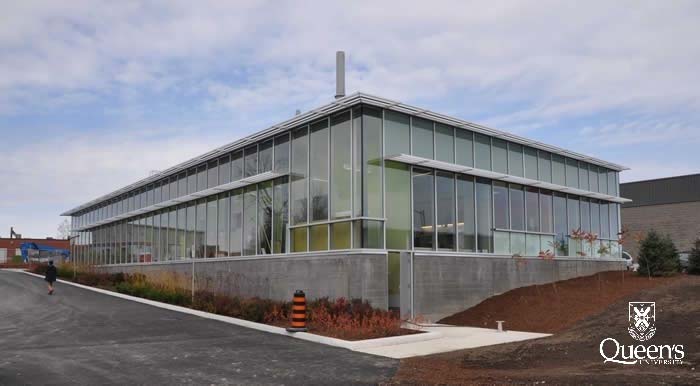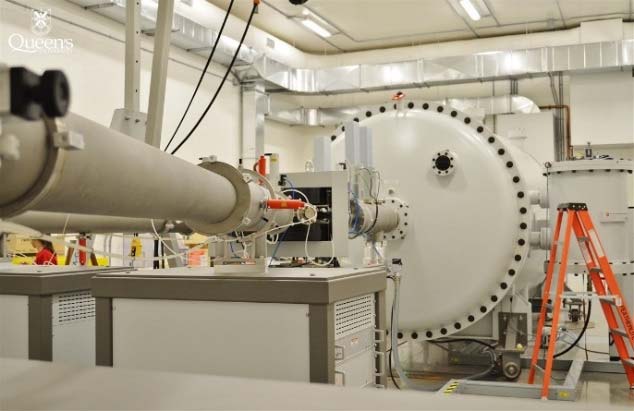Since its establishment in 2002 the Queen’s Nuclear Materials group has grown to its current composition of 6 faculty, and more than 25 students and postdocs. Led by Professor Mark Daymond who took over as Senior IRC in 2012, the Reactor Materials Testing Laboratory (RMTL) is a state-of-the-art, one-story facility that was officially opened in 2015. The facility includes a proton and helium accelerator to introduce radiation damage and transmutation products into materials, mimicking the changes to materials occurring in a nuclear reactor. In addition, the facility is equipped with a suite of equipment for testing mechanical and corrosion properties, as well as a range of characterisation equipment, including in situ capabilities.
With the current push to reduce our collective carbon footprint, nuclear power is transforming into the energy of choice for the world. Furthermore, it produces energy at a much lower cost, more effectively and with fewer adverse consequences for the environment than most other energy sources. On a global level, it is clear that nuclear power must contribute a significant proportion of power generation infrastructure over the next 50 years and beyond in order to maintain low carbon emissions.
It is clear that the data collected through studies at the RMTL will help develop strategies to extend the effective lifetime of existing, as well as, new nuclear reactors to support the more environmentally friendly energy path that the global community has chosen to tread.
Reactor Materials Testing Laboratory – Information Brief

The Reactor Materials Testing Laboratory (RMTL) is an exciting endeavour for Queen's Nuclear Materials researchers, led by Professor Mark Daymond. The RMTL uses a proton accelerator to introduce damage into materials at a microscopic scale. By studying the effects of this damage on the way that materials behave we can gain insight into, and draw parallels with, the way that materials are damaged within a nuclear reactor.
Made possible with the generous support of the Canada Foundation for Innovation and the Ontario Ministry of Research and Innovation, equipment manufacturers, Queen’s and Smith Engineering, the RMTL supports the development of safe and economical nuclear power for Canada. Nuclear power is an environmentally responsible source of electricity that will be a major component of global power generation in the future. It produces electricity cheaply, more effectively and with fewer adverse environmental effects than most alternatives. It contributes to the Canadian economy, especially in Ontario where >50% of our electricity is generated by nuclear power, supporting about 20,000 jobs. The Canadian nuclear industry as a whole currently employs more than 30,000 workers and contributes ~B$10 / year to the economy.
Internationally there is a world‐wide resurgence of investment in nuclear power. This has partly come from a desire to operate existing reactors beyond their originally planned lifetimes, but is also combined with a realization that nuclear power must be a major component of power generation infrastructure over the next 50 years and beyond if countries wish to maintain low carbon emissions. Correspondingly, there is a renewed interest in research within the area of structural materials for nuclear power applications.
Accelerator Technology

Materials behave quite differently in a nuclear power reactor environment than in conventional applications. The differences are due to the damage to the atomic structure of the materials caused by fast particles; in a reactor these particles are the neutrons that allow the nuclear reaction to occur.
The RMTL will investigate these materials issues using an approach based on the use of accelerator technology. By accelerating protons to moderately high energies, we can introduce damage into small pieces of material. This simulates the effects occurring in a reactor, allowing us to investigate the way that materials respond to stress and temperature. The goal is to develop a better understanding of the way that materials operate in a reactor, leading to the safe, long‐term running of reactors. The laboratory includes a state‐of‐the‐art electron microscopy suite (SEM, TEM) for characterization of materials that have been in the accelerator, and nano‐indentation testing to see the effect on mechanical properties.
A Leader in Nuclear Materials Testing
The RMTL will be an internationally leading research laboratory. Its construction is the culmination of more than a decade of investment in nuclear materials research at Queen’s through the NSERC/UNENE Industrial Research Chair (IRC) in NuclearMaterials, which is supported by Ontario Power Generation (OPG) and CANDU Owners Group (COG) through UNENE. The IRC started at Queen’s in 2002 at the initiative of Professor Rick Holt (now Emeritus), who also conceived and initially led the RMTL project. The Queen’s Nuclear Materials Group, which has grown to its present complement of twenty‐five since the program started in 2002, has developed the expertise to fully exploit the capabilities of the RMTL. Additionally, the RMTL will attract researchers from elsewhere in Canada and internationally. Existing partners in the RMTL research program include: McMaster University, Western University, the Royal Military College, University of Toronto, University of Ontario Institute of technology, Imperial College and Manchester University, Pennsylvania State University and the Australian Nuclear Science and Technology Organization. The project has been supported by OPG, COG, the University Network of Excellence in Nuclear Engineering (UNENE) and Atomic Energy of Canada Limited (now Canadian Nuclear Laboratories).